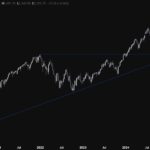Eurozone’s Current Account Surplus Soars to €33.1 Billion: Key Insights for February 2025
Tháng 4 16, 2025
Navigating Market Uncertainty: What’s Next for the S&P 500?
Tháng 4 16, 2025Recent Gold Price Developments and Forecasts: What Investors Need to Know
As global economic uncertainty continues to dominate the financial landscape, gold has emerged as a notable safe-haven asset, with recent price developments highlighting its increasing appeal among investors. Currently, the price of gold has surged above $3,300, reflecting a robust upward trend that has caught the attention of analysts and investors alike.
Current Price Movement and Historical Context
The leap above $3,300 for gold marks a pivotal moment in its price trajectory. In April 2025, gold hit a remarkable high of $3,246, symbolizing a growing recognition of gold’s importance as a hedge against volatility and instability. With ongoing geopolitical tensions and economic fluctuations, this shiny metal’s allure has grown significantly. Investors are responding to the uncertain economic climate, opting for gold as a reliable store of value amidst fears of inflation and fluctuating currencies.
Forecasts from Major Financial Institutions
In an encouraging sign for gold investors, major financial institutions such as Goldman Sachs and UBS have recently adjusted their price forecasts for gold upward. Goldman Sachs has set a target of $3,700 for the year-end, while UBS anticipates gold prices to reach about $3,500. These revised projections stem from a confluence of factors, notably increasing tariff uncertainties and escalating inflationary pressures, which are compelling investors to gravitate toward gold as a protective measure in their portfolios. For more insights on avoiding common investment mistakes during such turbulent times, check out this article on key investment mistakes to avoid in 2023.
Driving Factors Behind the Bullish Trend
Several key driving factors are contributing to the ongoing bullish trend in gold prices. Primarily, the rising U.S. inflation rate, recorded at 2.4% in March 2025, has triggered a wave of investor caution. Inflation naturally erodes purchasing power, and in an environment where traditional assets may falter, gold emerges as an attractive alternative. Moreover, concerns surrounding a potential protracted trade war with China have stoked fears of stagflation—a situation that could significantly impact economic growth and consumer confidence. To further understand the strategic moves being made in response to such issues, read about three strategic moves by China under Xi Jinping.
Investment Outlook: Gold’s Long-Term Appeal
Despite the inherent volatility that often accompanies gold trading, many analysts are optimistic about its long-term prospects. The consensus is clear: gold continues to be a compelling option for those seeking refuge in turbulent times. Its historical resilience during economic downturns positions it favorably as a strategic asset in diverse investment portfolios. As economic indicators signal uncertainty and potential turmoil, investors are increasingly recognizing gold’s value—both as a hedge against inflation and as a means of diversification. For further tips on maintaining a balanced mindset in investing, consider exploring this article featuring investment mistakes to avoid for success.
In conclusion, the recent developments in gold prices underscore its importance in the current economic climate. With solid forecasts from reputable financial institutions and a backdrop of rising inflation and geopolitical tensions, gold is likely to remain a focal point for investors navigating through uncertain financial waters. Whether driven by historical trends or modern challenges, gold’s intrinsic value continues to resonate with those looking for stability in an ever-shifting economic landscape.
